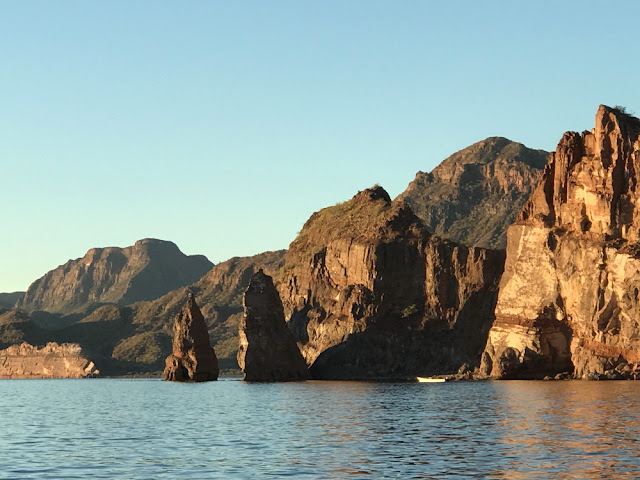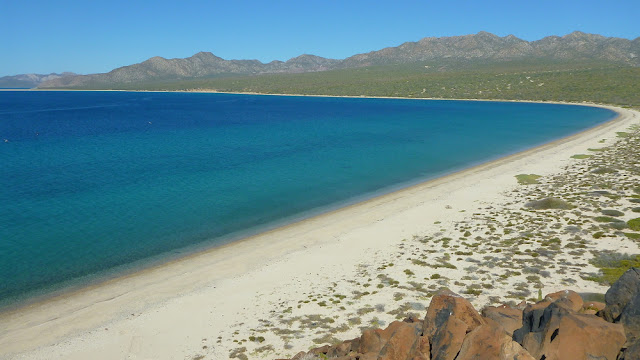Our sea kayaking adventure began in Loreto, home of California's first mission (1697). The two sits beneath the spectacular Sierra de La Giganta. These rocks are part of a volcanic sequence erupted between 25 and 17 million years ago in spectacular ask flow sheets (thus the layering seen in the background. Puerto Escondido (Hidden Port) seen here was the start of our adventure.
Helen is ready for some beach time. Our lead guide, Hugo can be seen explaining the days activities to Bryan.
Once out of Puerto Escondido we could see the island of Danzante.
The coast is quite rugged here, having ben split from mainland Mexico beginning about 12 million years ago.
Spectacular volcanic sequence at our first nights camp.
Camp scene.
Sunrise over the Gulf of California, also known as the Sea of Cortez.
Don, an old friend from California, catches a big one.
Our first morning out for a sunrise fishing expedition was the most productive with seven mackerel caught. These provided for a nice h'ordeuvre that evening.
Professional fishermen out at sunrise. Our guides would occasionally buy fish from them on the spot.
Morning light on the coast.
All along the coast, for days, we saw the impressive mountain front of the Sierra de La Giganta. At the time of the eruptions, this was still a part of the continental mainland. Only after the flows had cooled and hardened did the rifting begin as Baja became separated from the mainland. Erosion has since etched into the mountain front.
A beautiful cut-and-fill sequence where older deposits in the lower right were eroded into a large channel (perhaps by a river) and then filled with younger deposits (lower left). Exposures like these show the dynamic nature of the volcanic environment at this time (approximately 20 million years ago).
The kayaks lined up and ready to go.
Our second night's camp was in a beautiful bay surrounded by red sandstone.
This sandstone most likely was laid down during the initial rifting phase of the peninsula. The sand was derived from the enclosing mountains and then laid down in the deepening trough.
Typical camp scene on a Baja beach.
We experienced excellent weather during our trip with little wind and warmish temperatures. This peaceful scene says it all.
A surprise awaited us on the next morning — three fin whales - Earth's third largest species of whale.
They definitely were interested in our boats and swam repeatedly under them to look at us more closely. Fin whales are up to 75 feet in length. In this pod were two adults and one juvenile.
They played with us for over 15 minutes, then were gone. A recent study has postulated that between 100 and 700 of these whales may be using the rich Gulf of California ecosystem year round. See the results here.
At lunch we went into a side canyon and saw an old dugout canoe. This is a single log carved out to make a boat.
Helen and Beth in a more modern craft on the Sea of Cortez.
Early sunset...
Later sunset...
Night time scene with Orlando on guitar.
Bryan and Chris enjoying the music.
Night time scene.
A beautiful Baja morning!
I took a short hike back behind the camp on Isla San Jose. The mountains here are framed by the giant Cardon cactus (Pachycereus pringlei). The largest specimen ever recorded has been measured at 63 feet. They can be confused with Arizona's Saguaro cactus but Cardon's have arms growing out from the base, whereas Saguaro's have them farther up the trunk.
The skull of an eel on our table made for an interesting sight.
Heading out to sea on the west side of Isla San Jose.
Deserted beaches.
Skeleton of a puffer fish.
Don and Norm enjoy the end of the day at Punta Arenas on the peninsula.
We had wonderful, fun ladies on this trip - Christine, Helen, Kim, Chris, and Anne. Their joy and humor was welcomed relief from all of jokes from the guys.
Los Islotes near Isla Espíritu Santo. This erosional remnant contains rhyolite ash and ignimbrite.
Swarms of mackerel during a snorkel.
Isla Espíritu Santo has a wonderful exposure of rhyolite ash (lower brown) capped by black glass or basalt. On top of this is a slope-forming ignimbrite, itself capped by two remnants of rhyolite lava.
Bill and Beth in the clear water off Isla Espíritu Santo.
The four Pomonan's - Alan, Don C., Wayne and Don W. I knew everyone on the trip as either a childhood friend, high school or Arizona. It was a fantastic group.
The mission in Loreto, where my next post will pick up.










































No comments:
Post a Comment
If your comment will not post, email me with the problem.